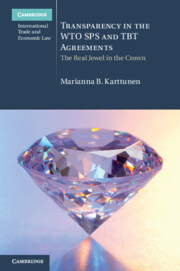Book contents
- Transparency in the WTO SPS and TBT Agreements
- Cambridge International Trade and Economic Law
- Transparency in the WTO SPS and TBT Agreements
- Copyright page
- Dedication
- Contents
- Figures
- Tables
- Foreword
- Acknowledgements
- Abbreviations
- Table of Cases
- Country Classification
- Introduction
- Part I Why the SPS and TBT Agreements?
- PART II Transparency as a Substitute for Dispute Settlement
- 4 The Steps in the WTO Disputing Pyramid
- 5 The Content of the WTO Disputing Pyramid
- Conclusion of Part II
- Part III Transparency as a Complement to Dispute Settlement
- Conclusion
- Appendices
- References
- Index
Conclusion of Part II
from PART II - Transparency as a Substitute for Dispute Settlement
Published online by Cambridge University Press: 28 April 2020
- Transparency in the WTO SPS and TBT Agreements
- Cambridge International Trade and Economic Law
- Transparency in the WTO SPS and TBT Agreements
- Copyright page
- Dedication
- Contents
- Figures
- Tables
- Foreword
- Acknowledgements
- Abbreviations
- Table of Cases
- Country Classification
- Introduction
- Part I Why the SPS and TBT Agreements?
- PART II Transparency as a Substitute for Dispute Settlement
- 4 The Steps in the WTO Disputing Pyramid
- 5 The Content of the WTO Disputing Pyramid
- Conclusion of Part II
- Part III Transparency as a Complement to Dispute Settlement
- Conclusion
- Appendices
- References
- Index
Summary
Part II offered an overview of how WTO Members use the SPS and TBT transparency tools, and how these constitute the very basic levels of the SPS and TBT ‘disputing pyramid’. The notifications centralised by the WTO are generally an important source of the information of which WTO Members – including a number of developing countries – make extensive use, but specific trade concerns (STCs) are still needed alongside these notifications if Members are to obtain further insights on the impacts of measures and in instances of non-notified measures. The ‘cross-notification’ that raising STCs in the SPS and TBT Committees grants to Members allows them to perform a monitoring role, ensuring that the measures of their trading partners are consistent with their WTO obligations. Scott refers to this as ‘mutual accountability through mutual oversight’. The technical and informal quality of the discussions in Committee largely allow this oversight to be non-confrontational, and this allows Members to co-operate towards mutually acceptable implementation of the SPS and TBT Agreements.
- Type
- Chapter
- Information
- Transparency in the WTO SPS and TBT AgreementsThe Real Jewel in the Crown, pp. 214 - 216Publisher: Cambridge University PressPrint publication year: 2020



